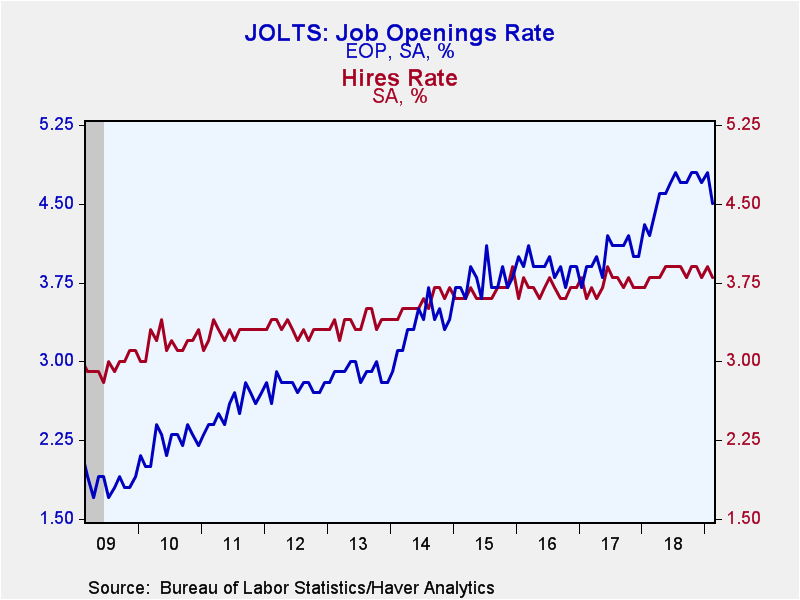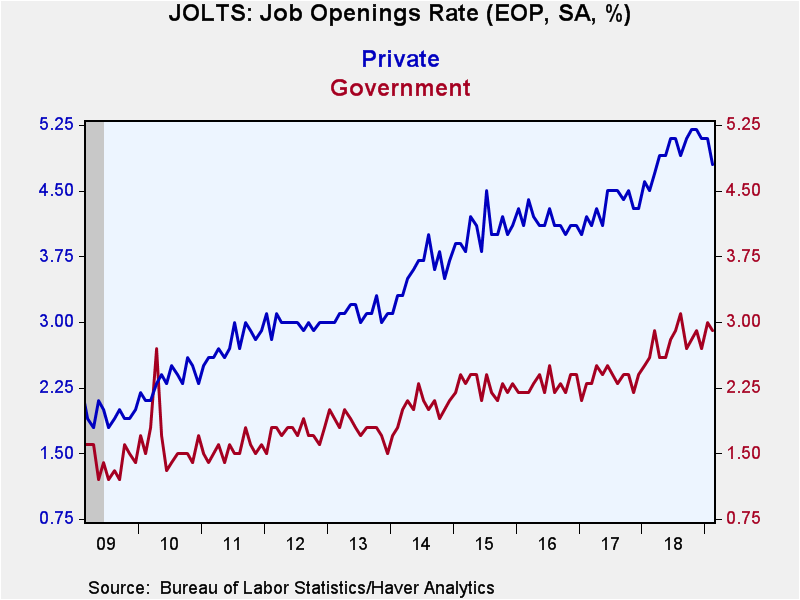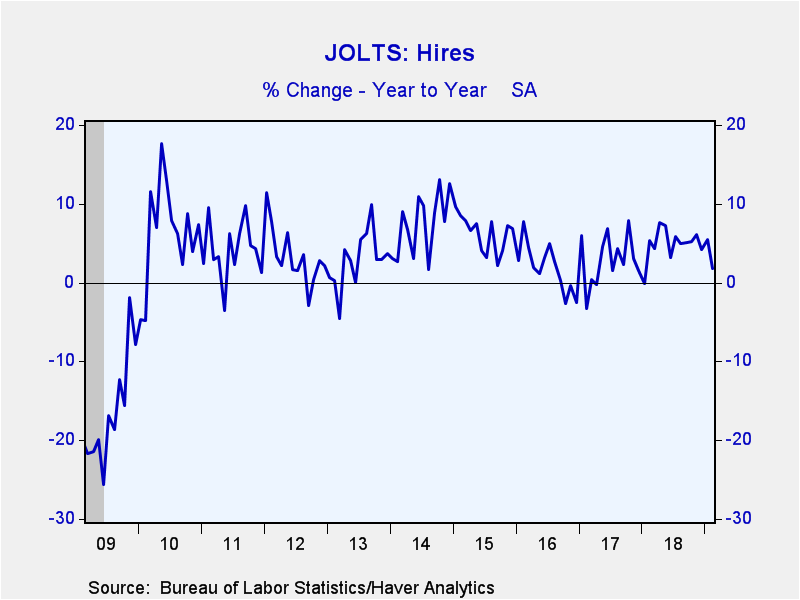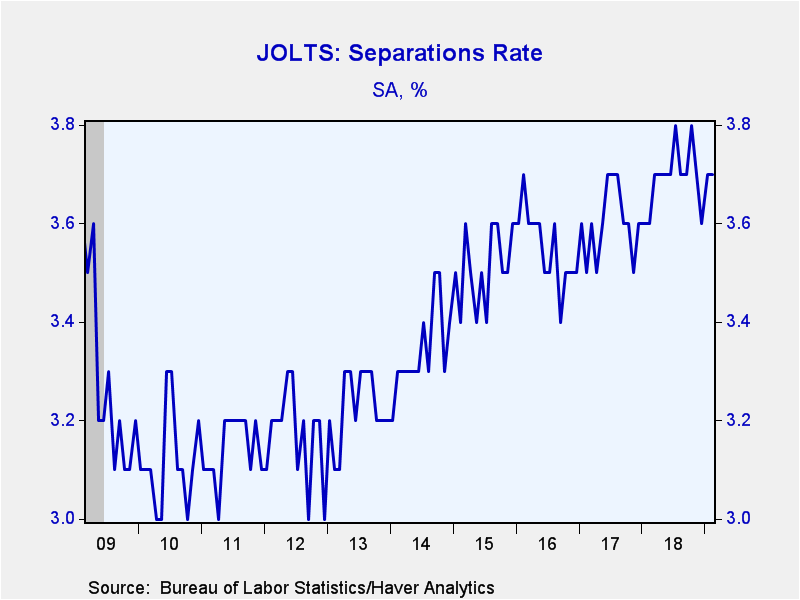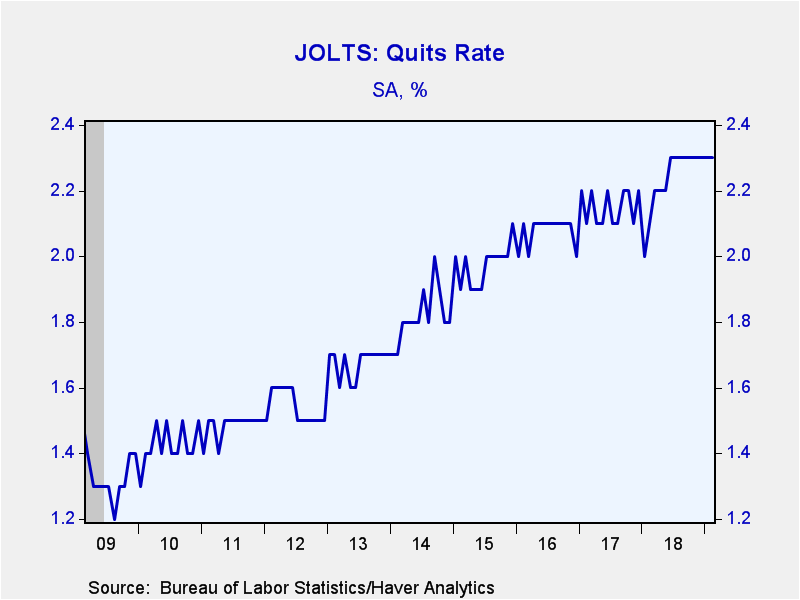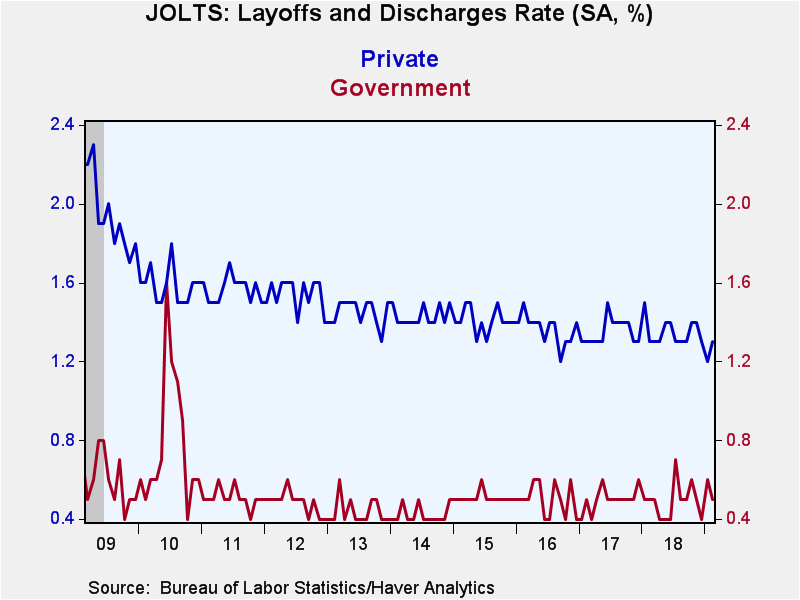 Global| Apr 09 2019
Global| Apr 09 2019U.S. JOLTS: Job Openings and Hiring Diminish
by:Tom Moeller
|in:Economy in Brief
Summary
The Bureau of Labor Statistics reported that the total job openings rate declined to 4.5% during February, its lowest level since March 2018. The job openings rate is the job openings level as a percent of total employment plus the [...]
The Bureau of Labor Statistics reported that the total job openings rate declined to 4.5% during February, its lowest level since March 2018. The job openings rate is the job openings level as a percent of total employment plus the job openings level. Finding workers to fill openings just became more difficult. The hiring rate eased to 3.8% and has been moving sideways for about a year. Employers became a little less hesitant to let people go. The layoff & discharge rate rose from the record low to 1.2%. And with jobs plentiful, workers remained ready to seek out new positions. The quits rate held steady at a near-record 2.3%. The JOLTS data begin in 2000.
The private-sector job openings rate declined sharply to 4.8%, the lowest level since March of last year. In leisure & hospitality, the rate dropped to a roughly one-year low of 5.5%. In professional & business services it eased to 6.3%, but remained up from 5.2% twelve months earlier. In education & health services, the rate fell to 5.0% from the record 5.4%, and in trade, transportation & utilities, it fell sharply to 4.4%, the lowest point since November 2017. The rate eased to 3.7% in construction but in manufacturing it improved to 3.7%, up from 3.3% twelve months earlier. The government sector job openings rate eased to 2.9%, and remained up sharply from the 2009 low of 1.2%.
The level of job openings declined 7.1% to 7.087 million (+8.5% y/y). Private-sector openings fell 7.5% (+8.1% y/y) while government sector job openings were off 2.2% (+12.6% y/y).
The private-sector hiring rate held steady at 4.2% but remained below May's eleven-year high of 4.4%. The rate in leisure & hospitality eased to 6.5%, but in professional & business services, it rose to 5.5%. The rate remained below the 2017 high of 6.1%. The construction sector's hiring rate declined sharply to 4.8%, the lowest level since September 2016. The hiring rate in trade, transportation & utilities improved to 4.2% after falling sharply in January. In education & health services, the rate held steady for a second month at 3.0%. In manufacturing, the rate fell to 2.7%. The hiring rate in government fell to 1.6%.
Total hiring rose a lessened 1.8% y/y to 5.696 million. Hiring in the private sector rose 1.9% y/y while government sector hiring gained 1.1% y/y.
With the strong labor market, the overall job separations rate has risen to 3.7% and remained near the expansion high. The private sector separations rate increased to 4.1%, but was below the cycle high of 4.2% reached in July. The separations rate in government rose slightly to 1.6%.
The level of separations strengthened 5.4% y/y. In the private sector, they were up 5.2% y/y led by a 15.1% surge in the construction sector. In educational and health services, separations rose 10.3% y/y and in trade, transportation & utilities, separations rose 9.5% y/y. Leisure & hospitality job separations increased 2.1% y/y but in manufacturing, they fell 2.0% y/y. In the financial sector, separations decreased 4.7% y/y. Separations in the information sector also declined 3.3% y/y but professional & business services job separations rose 3.0% y/y. Separations in the government sector increased 8.2% y/y.
In another sign of a strong labor market, the level of quits rose 9.6% y/y to 3.480 million in February. The quits rate of 2.3% remained steady m/m, though it remained up sharply from 1.3% at the beginning of the expansion. The private-sector quits rate held at 2.6%, the highest level in 13 years. The government sector quits rate held steady at the record 0.9%.
The level of layoffs in the private sector declined 1.2% y/y, and the layoff rate remained near the record low at 1.3%, down from the 2009 high of 2.2%. The government sector layoff rate held at the record low at 0.5%.
The Job Openings & Labor Turnover Survey (JOLTS) dates to December 2000 and the figures are available in Haver's USECON database.
| JOLTS (Job Openings & Labor Turnover Survey, SA) | Feb | Jan | Dec | Feb'18 | Fed'17 | Feb'16 |
|---|---|---|---|---|---|---|
| Job Openings, Total | ||||||
| Rate (%) | 4.5 | 4.8 | 4.7 | 4.2 | 3.9 | 3.9 |
| Total (000s) | 7,087 | 7,625 | 7,479 | 6,530 | 5,875 | 5,747 |
| Hires, Total | ||||||
| Rate (%) | 3.8 | 3.9 | 3.8 | 3.8 | 3.6 | 3.8 |
| Total (000s) | 5,696 | 5,829 | 5,717 | 5,594 | 5,313 | 5,493 |
| Layoffs & Discharges, Total | ||||||
| Rate (%) | 1.2 | 1.1 | 1.2 | 1.2 | 1.2 | 1.3 |
| Total (000s) | 1,742 | 1,695 | 1,751 | 1,763 | 1,687 | 1,913 |
| Quits, Total | ||||||
| Rate (%) | 2.3 | 2.3 | 2.3 | 2.1 | 2.1 | 2.1 |
| Total (000s) | 3,480 | 3,483 | 3,391 | 3,176 | 3,076 | 2,982 |
Tom Moeller
AuthorMore in Author Profile »Prior to joining Haver Analytics in 2000, Mr. Moeller worked as the Economist at Chancellor Capital Management from 1985 to 1999. There, he developed comprehensive economic forecasts and interpreted economic data for equity and fixed income portfolio managers. Also at Chancellor, Mr. Moeller worked as an equity analyst and was responsible for researching and rating companies in the economically sensitive automobile and housing industries for investment in Chancellor’s equity portfolio. Prior to joining Chancellor, Mr. Moeller was an Economist at Citibank from 1979 to 1984. He also analyzed pricing behavior in the metals industry for the Council on Wage and Price Stability in Washington, D.C. In 1999, Mr. Moeller received the award for most accurate forecast from the Forecasters' Club of New York. From 1990 to 1992 he was President of the New York Association for Business Economists. Mr. Moeller earned an M.B.A. in Finance from Fordham University, where he graduated in 1987. He holds a Bachelor of Arts in Economics from George Washington University.


